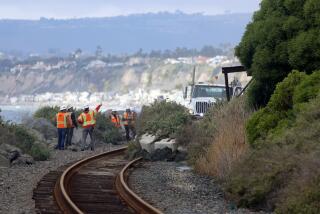Santa Fe Clears Major Hurdle in Merger Attempt : Pact With Union Pacific to Share Track May Meet ICC Objections to Deal
- Share via
Santa Fe Southern Pacific Corp. said Monday that it has reached an agreement with a major competitor that could clear the way for the merger of the company’s two railroads, which was unexpectedly blocked in July.
The parent companies of Santa Fe Railway and Southern Pacific Co. merged in 1983, but Santa Fe Southern has been required to operate its rail subsidiaries separately ever since.
Then, in July, the Interstate Commerce Commission rejected the proposed merger as anti-competitive, although it gave Santa Fe Southern until next Monday to file a petition to reopen the case. A company spokesman said the petition will be filed before the deadline.
In the agreement announced Monday, Santa Fe Southern would grant Union Pacific Railroad, the biggest competitor to object to the merger, the right to use some of Southern Pacific’s and Santa Fe’s track if the merger is approved.
In exchange, Union Pacific agreed to work with Santa Fe Southern “to demonstrate to the ICC how this agreement addresses the public interest issues raised by that agency,” the two companies said in a joint announcement. Santa Fe Southern would also be granted access to certain Union Pacific rails.
Areas of Concern
The ICC said in July that it was particularly concerned about a lessening of competition along the railroads’ “southern corridor” from Southern California to the Gulf Coast, within California and along the “central corridor” from Northern California to the Midwest.
Santa Fe Southern subsequently reached an agreement with the Denver & Rio Grande Western Railroad to answer the ICC’s objections about the central corridor.
“This is our effort to satisfy concerns about the competition in the southern corridor,” Santa Fe Southern spokesman Robert Gehrt said. “But we can’t presume to predict how the commission will react.”
“I think it’s a pretty encouraging thing,” Andras Petery, a railroad analyst with the investment house of Morgan Stanley, said. “I think this is the kind of deal the commission was looking for.”
James Voytko, an analyst with Paine Webber, said that because Santa Fe Southern and Union Pacific had reached agreement “the odds clearly have gone up some that the commission will reconsider the decision.”
Under the agreement, Union Pacific would get access to Santa Fe Southern’s rails from El Paso, Tex., to Colton, Calif., and north to Lathrop, near Stockton. The Lathrop-Colton route will be Union Pacific’s first north-south route in California; the route to El Paso will provide a connection with the railroad’s lines from the East, Union Pacific spokesman John Bromley said.
Santa Fe Southern would get access to Union Pacific tracks in parts of Texas, Kansas and Illinois, which will give the company a shorter route across Texas, improved access to Gulf Coast chemical plants and a shorter route between the Gulf Coast and Chicago, Gehrt said.
Union Pacific has estimated that the agreement will mean revenue of $97 million a year in traffic diverted to Union Pacific from Santa Fe Southern, Bromley said. Virtually no traffic would be diverted to Santa Fe Southern, he said. However, Gehrt noted that the trackage rights would improve Santa Fe Southern’s efficiency.
Union Pacific reserved the right to contest Santa Fe Southern’s agreement with Denver & Rio Grande, which introduced a third competitor in an area controlled by Union Pacific and Santa Fe Southern. “This agreement does not suggest that we are satisfied with everything as it now stands,” Bromley said.
More to Read
Inside the business of entertainment
The Wide Shot brings you news, analysis and insights on everything from streaming wars to production — and what it all means for the future.
You may occasionally receive promotional content from the Los Angeles Times.










